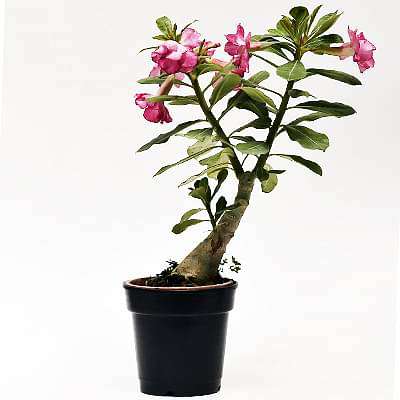Description
Climbing roses usually need support by securing to a pillar, fence or wall but some can be grown more as a shrub. Some are also suitable as a groundcover. Many rebloom throughout summer but some flower just once in spring.
Note: The fragrance of Rose flowers depends on its variety and climatic conditions, hence this plant may or may not produce fragrant flowers.Rosa is a genus of about 150 species of deciduous (occasionally evergreen) shrubs and climbers noted for their beautiful, often fragrant, single, semidouble or double flowers which are borne singly or in clusters on often prickly stems clad with 5-9 leaflets often having toothed margins.Plant Specifications*above specification are indicative only. actual dimensions may vary by +-10%
Common Name
Climbing miniature rose
Maximum Reachable Height
Up to 10 feet
Flower Colour
Rani Color
Bloom Time
May to frost
Difficulty Level
Easy to grow
Planting and careDig a hole the same depth as the pot the rose came in and about a foot wider.Carefully remove the rose from the pot and gently loosen the roots. If the plant is tightly root bound, use a sharp knife to score the sides of the root ball and try again to loosen the roots.Add some organic matter to the soil in the hole, if needed.Place the rose bush in the center of the hole, with the roots spread out.Thoroughly water the newly planted bush and then apply a layer of mulch.Miniature Rose care
Well-drained sandy loam with pH of 6-7 is suitable. Bright sunshine for a minimum of 6 hours is essential for the cultivation of roses. Apply fertilizers with little or no nitrogen content later into fall. Organic fertilizers include manure, compost, or other plant and animal products. After pruning in October and again in July the plants are manured with FYM 10 kg and 6:12:12 g of NPK per plant.
Sunlight
Full sun
Watering
Medium
Soil
Well drained soil
Temperature
Around 68 degrees F
Fertilizer
Apply fertilizers with little or no nitrogen content later into fall. Organic fertilizers include manure, compost, or other plant and animal products.
Miniature Rose special feature
Roses have a mild tea fragrance. Deep green foliage. Also may be grown as a self-supporting shrub.
Miniature Rose uses
Ornamental Use:
It is used for the ornamental plant
Medicinal Use:
The rose hip, usually, is used as a minor source of Vitamin C
The fruits of many species have significant levels of vitamins and have been used as a food supplement
Many roses have been used in herbal and folk medicines
Some species have been used for stomach problems, and are being investigated for controlling cancer growth
Note: Used only after consulting the specialist
Culinary Use:
Rose hips are occasionally made into jam, jelly, marmalade, and soup or are brewed for tea, primarily for their high vitamin C content
They are also pressed and filtered to make rose hip syrup
Rose petals or flower buds are sometimes used to flavor ordinary tea or combined with other herbs to make herbal teas






Reviews
There are no reviews yet.